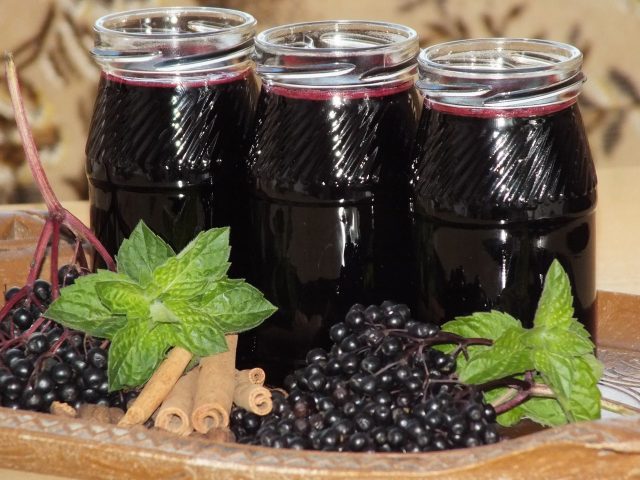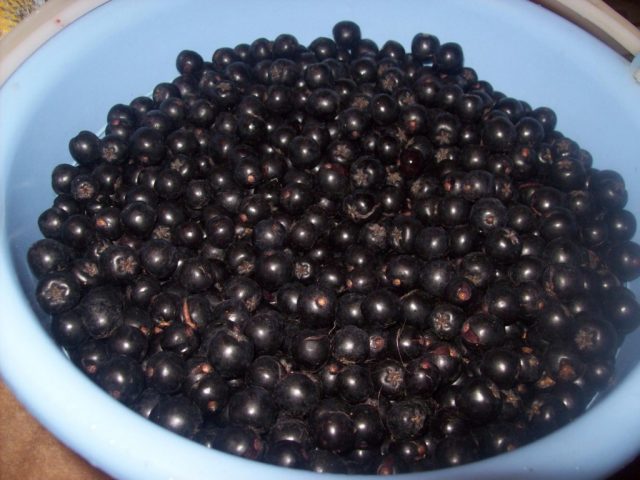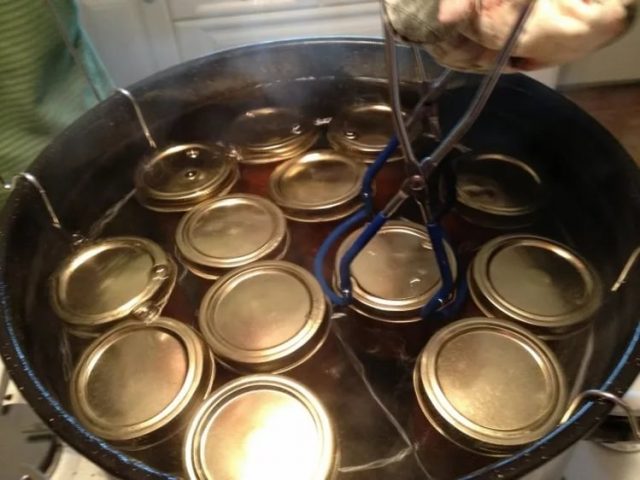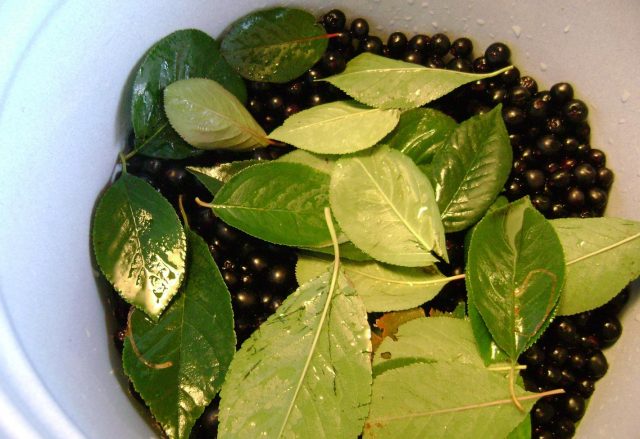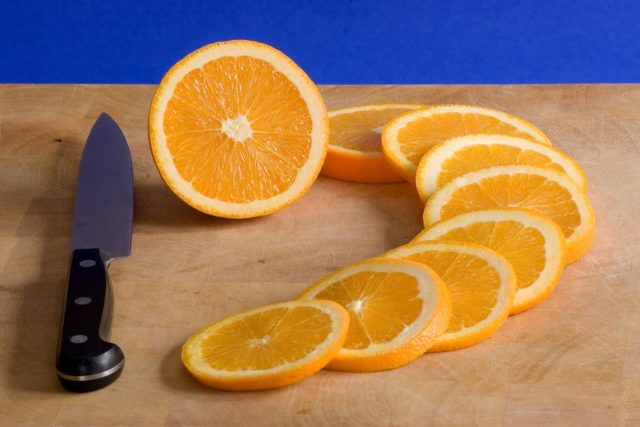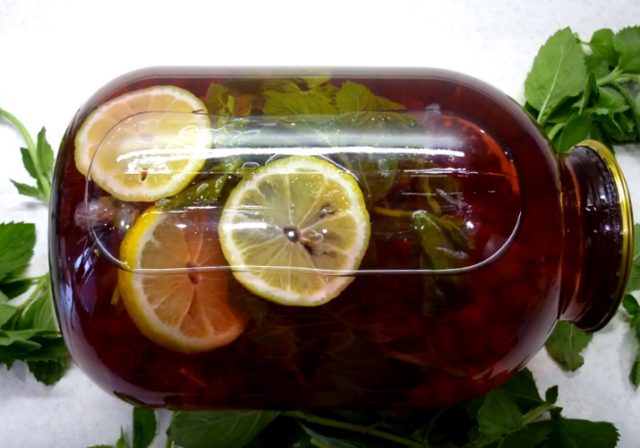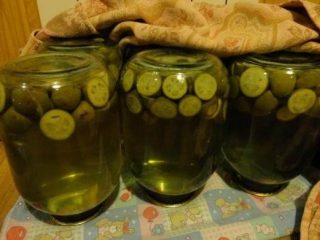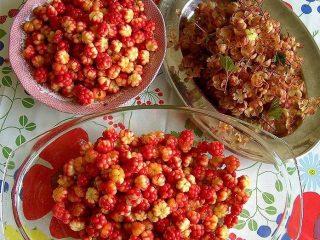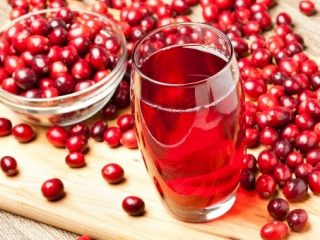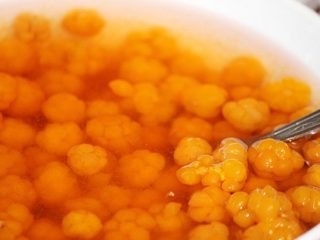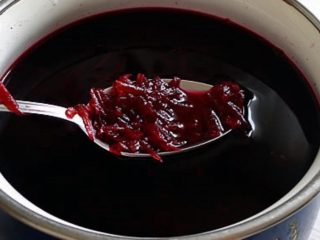Content
- 1 The benefits and harms of chokeberry compote
- 2 How to prepare chokeberry compote correctly
- 3 Classic recipe for chokeberry compote
- 4 A simple recipe for chokeberry compote
- 5 Chokeberry compote for a 3 liter jar
- 6 Chokeberry compote for the winter without sterilization
- 7 Compote of chokeberry with cherry leaf
- 8 Compote of sea buckthorn and chokeberry
- 9 Compote of plums and chokeberries
- 10 Frozen chokeberry compote
- 11 How to cook chokeberry compote with grapes
- 12 Compote of chokeberry with orange
- 13 Compote of chokeberry and pear
- 14 How to cook chokeberry and raspberry compote
- 15 Compote of chokeberries and currants
- 16 Recipe for black rowan compote with lemon and mint
- 17 How to cook compote from chokeberry and cherry plum
- 18 Compote of black and red rowan
- 19 Rules for storing chokeberry compotes
- 20 Conclusion
Chokeberry compote for the winter is easy to prepare, stores well and can support the body during the cold season. The ruby color and pleasant tartness of the berries are successfully combined with the aromas of garden berries, herbs, and autumn fruits. By adjusting the sweetness, as well as the concentration of the compote, you can make this healthy drink enjoyable for children and indispensable for adults.
The benefits and harms of chokeberry compote
The unique composition of chokeberry berries gives it many beneficial properties. One way to preserve this delicious medicine throughout the winter is to make a bright ruby, healing drink. The benefits of chokeberry compote are due to the rich chemical composition of the berries, which suffer little from heat treatment.
Retinol, tocopherol, vitamins C, A, and almost the entire series of group B were found in the fruit pulp.
Chokeberry contains the following valuable substances:
- iodine;
- selenium;
- manganese;
- molybdenum;
- iron;
- copper;
- fluorine and many other compounds.
The presence of tannins, terpenes, pectins, and acids perfectly protects any chokeberry product from souring in winter. These natural preservatives, each individually, also exhibit medicinal properties, and when collected in one berry they create a real elixir of health.
The active substances in chokeberry fruits are balanced in such a way that they have a complex effect on several organs and systems at once:
- Strengthens the body's immune defense.
- They treat vitamin deficiency, anemia, and improve the blood count.
- Strengthens blood vessels, cleanses them of atherosclerotic deposits.
- Reduce cholesterol and blood glucose levels.
- They reduce blood pressure and serve as a mild diuretic.
- Promotes the removal of toxins and radionuclides.
- Protects from exposure to ultraviolet radiation.
Regular consumption of chokeberry compote will improve brain function, enhance memory, and relieve stress. In winter, chokeberry drinks are taken to prevent colds, infections, and depression.
Black berries should be perceived as a medicine, the excessive consumption of which can be harmful to health. The concentration of compotes usually does not pose a risk of overdose. However, along with its beneficial properties, chokeberry has a number of contraindications. It is not recommended to drink chokeberry compote in the following conditions:
- Personal intolerance to fruits.
- Increased stomach acidity, ulcerative processes in the gastrointestinal tract.
- Reduced blood pressure.
- High blood clotting, thrombophlebitis.
- Tendency to constipation.
Be careful when offering chokeberry compotes to children under 3 years of age. The content of black berries in a child's drink should be minimal.
How to prepare chokeberry compote correctly
One of the valuable properties of chokeberry is its ease of preparation. The dense pulp stores well in winter and does not require special processing before cooking. But the berries still have several features, which can be taken into account to improve the taste of the compote.
Principles for preparing chokeberry compote:
- The longer the berry remained on the bushes, the sweeter it is. Bitterness and astringency decrease after the first frost. Raw materials collected earlier can be frozen in the refrigerator.
- The collected chokeberry fruits are carefully sorted. Unripe specimens will taste bitter; dry and spoiled specimens will affect the preservation of the compote in winter.
- If possible, sorted berries are soaked in water 6-8 hours before cooking. This reduces astringency and softens the peel.
- The waxy coating is removed from the surface by pouring boiling water over the fruit. If the amount of chokeberry is more than 1 kg, it is convenient to blanch all the berries together for about 3 minutes in a large container with boiling water.
- To prepare compotes for the winter, glass cylinders with a capacity of 3 liters are traditionally chosen. If desired, you can use smaller containers, accordingly, calculating the amount of products according to the recipe. All utensils for long-term storage of compote in winter must be sterilized.
To preserve chokeberry preparations in winter, the amount of sugar and acid in recipes is not of fundamental importance. These additives are designed to improve the taste and color of the drink. The juice of the fruit itself is a powerful preservative for winter wraps. You can make chokeberry compote without sweetening or adding citric acid.
Classic recipe for chokeberry compote
The ratio of sugar to chokeberry in recipes depends on personal taste. The traditional combination of sweetness, acidity and berry flavor is achieved according to a recipe where 1 kg of prepared berries contains 1 kg of sugar. The addition of acid softens the taste, and the color changes from inky to rich ruby.
Ingredients for 1 kg of chokeberry:
- sugar – 1 kg;
- lemon juice – 50 g (or 1 tbsp. powder concentrate);
- drinking water (filtered) – 4 l.
A special feature of winter chokeberry recipes is the absence of the stage of boiling the berries in syrup. Compotes are prepared using the hot pouring method, which preserves maximum nutrients. The berries give off the color and taste of the liquid gradually, infusing in jars already sealed for the winter.
Preparing a classic compote for the winter:
- First, wash and sterilize all jars, lids, dishes and cutlery.For compote according to the traditional recipe, you will need dishes with a total capacity of about 6 liters.
- Blanched chokeberries are placed in jars, filling them to ½ of the volume.
- In a separate pan, cook a mixture of sugar, water, and citric acid. Boiling time is about 3 minutes.
- Boiling sweet solution is filled to the top with chokeberry jars.
- Cover the jars with lids without capping.
The next stage of the classic method of preparing compote for the winter involves additional sterilization. To do this, the jars are placed in a large pan filled with hot water. It is advisable to immerse the workpieces in boiling water up to their hangers.
Warm up 0.5 liter jars for 10 minutes, liter jars for about 15 minutes, 3 liter jars for at least half an hour. After sterilization, the workpieces are rolled up tightly, turned over onto lids, and wrapped warmly for slow cooling.
Such compotes infuse faster, acquiring a characteristic taste and ruby color. The sterilized product can be stored at room temperature in winter.
A simple recipe for chokeberry compote
The chemical properties of the berries make it possible to prepare drinks without sterilization and long-term cooking. The simplest recipe for chokeberry compote for winter storage involves the following calculation of food storage:
- The syrup is prepared by adding 200 g of sugar for every liter of water;
- chokeberries are measured when pouring into jars by eye, without weighing;
- the amount of chokeberry in a glass container should be at least 2/3 of the volume.
Pour pre-soaked chokeberries into sterile jars and pour boiling water over them. Cover loosely with lids and let sit for 10 minutes. Then the water is drained into a large saucepan where the syrup will be boiled.
Based on the resulting amount of liquid, measure the amount of sugar according to the recipe. Boil the sweet solution for several minutes and pour it into jars again. The sealed containers are left upside down until they cool.
Chokeberry compote for a 3 liter jar
Black rowan bears fruit well; the harvest from one bush is usually enough for a large number of preparations. Therefore, it is convenient to calculate the products for chokeberry compote for the winter directly into 3-liter jars. To measure the ingredients, you only need a container with a capacity of 500 ml.
Ingredients:
- chokeberry - 1 jar;
- citric acid – 1 tsp;
- 1 small orange;
- sugar - 1 jar.
Black berries are sorted, washed, and doused with boiling water. The orange is cut randomly, removing all the seeds. When adding citrus fruits along with the peel, they should first be scalded and wiped dry.
Cooking process:
- A measured amount of rowan is poured into a 3 liter container.
- Place mugs or slices of orange on top.
- Pour boiling water to the top and leave covered for 30 minutes.
- The cooled water is poured into a saucepan, sugar and acid are added according to the recipe.
- Heat the syrup for 5 minutes from the start of boiling and pour it over the berries again.
Now the compote can be sealed, wait for it to cool and place for storage in a cool, dark place.
Chokeberry compote for the winter without sterilization
Chokeberry prepared without prolonged heating can be perfectly stored in winter until the next harvest. But the hot pouring method in recipes requires adherence to certain rules:
- Rowan berries are carefully sorted, removing all unripe, damaged or spoiled ones. Remove all plant debris, leaves, twigs. When soaking, they get rid of sand and adhering soil particles.
- All raw materials and utensils in contact with the workpiece require sterilization with steam, boiling water or heating in the oven.
- When using chokeberries with petioles in recipes, you should blanch the berries as a whole bunch.
- To extend the shelf life of compote in winter, the raw materials in jars must be filled twice, draining the water and subjecting it to boiling.
- After sealing tightly, jars of hot compote are wrapped in thick cloth, a blanket or towel. This ensures self-sterilization of the workpieces.
- The characteristic color of the compote appears 10-14 days after pouring. Before this, the drink may remain pale and does not have a distinct taste.
Without heating the sealed jars, you can prepare chokeberry compotes for the winter according to many recipes. The main thing is to ensure that all additives (berries, fruits, leaves) are washed and blanched.
Compote of chokeberry with cherry leaf
Adding fruit tree leaves to the recipe gives chokeberry drinks a brighter taste. Compote of chokeberry with cherry leaf has such a pronounced aroma that it is difficult to determine the main ingredient.
To prepare 3 liters of compote you will need:
- chokeberry - at least 0.5 kg;
- sugar – 0.5 kg or more (to taste);
- cherry leaves (fresh or dried) – 15 pcs.;
- cherry juice – up to 250 ml;
- water - about 2 liters.
The recipe differs in the way the filling is prepared. Cherry leaves are infused in the syrup to impart flavor.
Cooking process:
- The leaves are washed and divided into two parts. Place one half in a saucepan, add water and boil for 5 minutes.
- The prepared berries are steamed with the decoction along with the leaves and left for 8 hours to soften.
- The rowan is placed in jars, and the infusion is boiled with sugar and the remaining leaves for another 5 minutes.
- At the end, pour in the juice and, after waiting for it to boil, remove the syrup from the heat.
- The leaves are removed with a slotted spoon, and the hot mixture is filled with jars of berries.
Depending on the method of storage in winter, the jars are sealed immediately or after sterilization.
Compote of sea buckthorn and chokeberry
The value of chokeberry compote increases many times when sea buckthorn is added to the recipe. This drink is especially useful in winter, during colds and vitamin shortages.
Compound:
- sea buckthorn – 250 g;
- chokeberry – 250 g;
- sugar – 250 g;
- water - about 2 liters.
The berries are poured into a 3-liter sterile container and filled with hot syrup. Compote of chokeberry and sea buckthorn, unlike other recipes for the winter, must be sterilized before rolling the lids.
Compote of plums and chokeberries
Autumn fruits go well with chokeberry in compotes. Late varieties of plums can be used in recipes, adding them equally with chokeberry.
Approximate composition for a 3 liter jar of compote:
- plum (red varieties with a detachable stone) – 300 g;
- black rowan – 300 g;
- sugar – 500 g;
- water – 2 l.
The plums are washed and divided into halves, removing the pits. Chokeberry is prepared as standard. The raw materials are poured into jars and then compote is prepared for the winter using the hot pouring method. In plum and chokeberry compote, the amount of sugar in the recipe is varied arbitrarily, depending on the desired sweetness of the finished drink.
Frozen chokeberry compote
After exposure to low temperatures, dense, black chokeberry more readily gives up color and nutrients to the solution.The skin of the chokeberry becomes porous after defrosting, and the berry does not require long soaking or blanching.
The ratio of products can be taken from any recipe, but the process of preparing for the winter is somewhat different.
Frozen chokeberry raw materials are placed in a cooking vessel, sugar is added, and acid is added. Fill the mixture with water, bring it to a boil and heat for another 10 minutes. The compote is poured into jars hot and sealed without sterilization; in winter, such a drink will be perfectly preserved at normal temperatures.
How to cook chokeberry compote with grapes
Compote from white or pink grapes may be fragrant but pale. Chokeberry is a good option for combining in recipes with this autumn berry. Moderate astringency and bright, rich color will give grape preparations for the winter a special appeal.
Compound:
- loose grapes – 300 g;
- chokeberry – 100 g;
- sugar – from 300 to 500 g;
- water - about 2.5 l.
Boil the syrup and pour it over the berries as usual. The recipe contains ingredients for a 3-liter bottle. There are yeast microorganisms on the skin of the grapes, so the compote should be poured with hot syrup at least 2 times if the drink is being prepared for the winter.
Compote of chokeberry with orange
Citrus aromas pleasantly diversify compotes. Oranges added to chokeberry create an unexpected combination reminiscent of the taste of cherries. To obtain this effect, it is enough to add 1 orange per 3 liters of compote to any basic recipe.
Features of the use of citrus fruits in recipes for chokeberry preparations for the winter:
- orange, cut with peel, is processed together with chokeberry;
- when using juice, it is added to the syrup before the end of cooking;
- It is permissible to boil the zest together with the syrup to release the aroma.
Otherwise, winter drinks are prepared as standard. Oranges in chokeberry compotes for children are sometimes replaced with tangerines. Citrus fruits are introduced into recipes in quantities of no more than 200 g per 3 liters of drink.
Compote of chokeberry and pear
Children really like this drink with a bright ruby color and a duchess flavor. Pears for harvesting for the winter are chosen with thick skin and pulp that retain their shape when heated.
Storing norms for one jar (3 l):
- pears - from 0.5 to 1 kg;
- sugar – from 1 cup to 500 g;
- chokeberry fruits - from 100 to 500 g (depending on the desired taste).
Large pears are cut into quarters. For the recipe, it is convenient to use small varieties, adding whole fruits, cutting off the tails. The raw materials are placed in jars along with berries and preserved with hot syrup. It is advisable to sterilize the pear and chokeberry compote for preservation during the winter.
How to cook chokeberry and raspberry compote
The addition of berries creates the main accent of taste in compotes made from chokeberry, which in itself does not have a strong aroma. The raspberry drink gets its rich color and noble tartness from chokeberry.
Compound:
- raspberries with dense pulp - 600 g;
- chokeberry (fresh) – 400 g;
- sugar - to taste (from 400 g);
- water – 1.5 l.
The peculiarity of cooking such a compote is the need to combine dense chokeberry berries with delicate raspberry pulp, which is prone to boiling. To combine such different components in one recipe, proceed as follows:
- The washed chokeberry fruits are blanched in water for about 10 minutes.
- The raspberries are not boiled, but immersed in the same boiling mixture without removing them from the sieve. After 1 minute, the blanched raw materials are quickly removed.
- Chokeberries and raspberries processed using this method are poured into jars and poured with boiling syrup.
The jars can be immediately sealed, wrapped and left for self-sterilization.
Compote of chokeberries and currants
Both berries give a similar color in drinks, and the taste of the compote will, without a doubt, be currant. An approximate stash of ingredients for a winter recipe looks like this:
- black currant – 500 g;
- chokeberry – 1 kg;
- sugar – 1 kg;
- water – 3 l.
Sorting and preparing two berries is painstaking work. The tails of currants and chokeberries should be removed. It is convenient to do this with scissors.
Both types of black fruits are cooked together: pour into a large saucepan, add sugar, pour in water. Over moderate heat, stirring, bring the mixture to a boil and let it simmer for another 5 minutes.
Clean jars are filled to the brim with hot compote, closed with tight lids, and left to infuse. For successful storage in winter, you can sterilize the preparations.
Recipe for black rowan compote with lemon and mint
Lemon is a classic chokeberry companion in any recipe. When acid is added, compote of ink berries acquires transparency and a reddish tint, is enriched with vitamins, and acquires a balance of sweetness/acidity.
Features of cooking compote:
- To prepare, take a classic combination from the basic recipe, in which the powder product is replaced with natural lemon.
- Citrus fruits for compote with chokeberry can be cut into large rings along with the peel and placed on top of the rowan in jars.
- Containers filled with chokeberry 2/3 with lemon slices are poured with boiling water. Set aside for 10 minutes and drain the liquid into a saucepan.
- Cook the syrup according to the standard scheme, increasing the amount of sugar by 100 g for each lemon above the recipe.
- 2-3 sprigs of mint are added to the sweet syrup at the end of cooking and allowed to brew for at least 15 minutes after turning off. Then the aromatic herb should be removed.
Hot syrup is poured into jars and left for up to 10 days before tasting or storing in the pantry for the winter.
How to cook compote from chokeberry and cherry plum
Cherry plum is a fairly sour product and perfectly balances the natural astringency of chokeberry in compotes.
Ingredients for 1 jar (3 l):
- ripe cherry plum fruits – 400 g;
- chokeberry berries – 200 g;
- sugar – 1 kg;
- water - about 2 liters.
Before blanching, each cherry plum fruit should be pricked. This way the raw material will not crack and the compote will not become cloudy.
Preparation:
- The prepared cherry plum is blanched together with the chokeberry for several minutes.
- The fruits are poured into a jar and filled with boiling water. Leave for 10 minutes.
- The liquid is separated by filtering through a special lid with holes.
- Prepare syrup from strained water and the entire portion of sugar, heating the mixture until it boils.
- Pour hot sweet solution into containers with fruits, filling them completely.
Seal the workpieces with sterile lids and leave them, turning them upside down, until they cool. For the winter, put the seams in a cool place.
Compote of black and red rowan
Both types of berries are processed the same way, so you can mix the fruits equally for recipes. The addition of red rowan increases the astringency and adds bitterness to the compote. In any recipe where part of the chokeberry is replaced with red rowan, it is permissible to increase the amount of sugar and acid to taste.
When blanching the fruit mixture, add a little salt to the water, which neutralizes some of the bitterness.Otherwise, follow any given recipe, not exceeding the norm for adding rowan mixture - 1/3 of a jar.
Rules for storing chokeberry compotes
Chokeberry stores well and in itself is a preservative for other products in compote when preparing for the winter. Drinks are suitable for consumption within a year after canning.
Some storage features:
- preparations for the winter with chokeberry should be protected from light;
- compotes can be stored in a cellar or other cool place for up to 24 months;
- Using ingredients with pits (cherries, cherry plums) in the recipe reduces the shelf life to 6 months.
Conclusion
Chokeberry compote for the winter is a delicious way to preserve the benefits of the berry. Bright drinks with a varied composition prove that supporting the body during the cold season can be tasty and varied. The strong medicinal properties of chokeberry in compotes acquire a mild, gentle effect and do not harm the body when taken in moderation.
